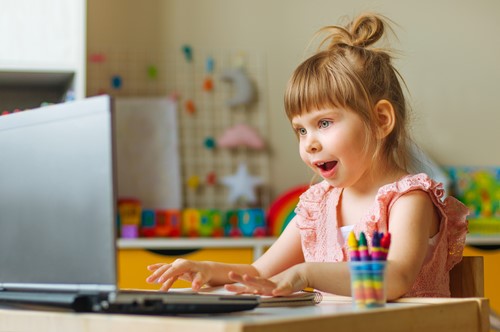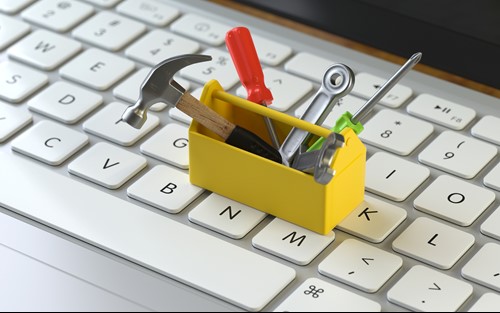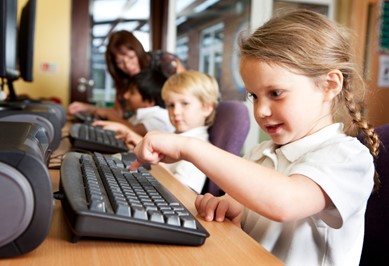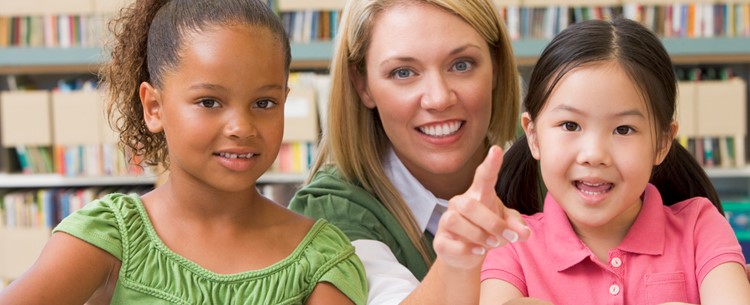THIS IS AN EXCERPT FROM MY ONLINE PD FOR EARLY CHILDHOOD EDUCATORS – HOW TO SUPPORT PLAY BASED LEARNING IN EARLY CHILDHOOD EDUCATION WITH DIGITAL TECHNOLOGY. You can gain instant access to this course by becoming a member of our Academy for just $5.99 AUD per month today
Understanding Digital Learning for Preschoolers
Digital literacy in early childhood education is about considering the use of digital technology in early childhood education for the early acquisition of digital skills to be part of young children’s communication development.
Many young children enter early learning environments with varying degrees of capabilities in digital technology. Therefore, for many early childhood educators teaching digital literacy in early childhood education is not about the question of technical competence, but more a question of being able to apply effective pedagogical interaction. Additionally, they also understand that ‘moral work’ also has further weight than dealing with technical competencies with digital technology in early childhood education.
The position statement from Early Childhood Australia, the main governing organisation in Australia for young children in education, titled “Statement on Young Children and Digital Technologies” clearly outlines how digital literacy can be achieved in the early years through four aspects of digital play – Relationships; Health and Wellbeing; Citizenship; and Play and Pedagogy.
For young children, it means developing skills in the use of images and sound to convey information, ideas and feelings about themselves, their activities, and their environment using electronic media. They will begin to develop skills to organise and analyse information.
Young children, with reference to the EYLF, will demonstrate how to use ICT to investigate and problem-solve, identifying uses of digital technology in everyday life, using digital technologies to access images and information, and to use digital technologies as tools for designing, creating, editing, drawing, reflecting and composing in meaningful play in early childhood education.
How is Technology used in Early Childhood Education?
Digital play in the early years is the early childhood pedagogy of choice for those who wish to support digital technology in early childhood education. Digital literacy activities for preschoolers include that which we cover in our full transformation and implementation online pd for early childhood educators. Here are are some of the ways we answer the question 'how is technology used in early childhood education'?
Digital storytelling
The use of digital storytelling in early childhood education brings with it many benefits for young children. Storytelling itself, makes us feel part of the community which is also important in the early learning setting. It teaches the story of life and shapes mental models. It encourages children to become creators of content, rather than just consumers.
Creative play with iPads
Creative development plays a very significant part in a young child’s learning in the early years curriculum. It is strongly linked to play, and the curiosity of children continues to drive the enhancement of their dispositions. Creativity in the early learning environment allows children to participate in and gain from learning. So, promoting creativity in early childhood education is vital to a young child’s learning and development.
Outdoor Play based learning
Digital technology in early childhood education such as iPads and other mobile technologies can also provide digital literacy activities for preschoolers when educators facilitate a structured learning environment that is scaffolded appropriately.
Other examples of digital literacy activities for early years include:
- Digital role play in early childhood education;
- Nurturing creativity in early childhood education with drawing and painting software.

How you can Best Define and Determine Digital Fluency in Preschool Today?
This is an extract from my play-based learning online course about "How to support play based learning in early childhood education with digital technology". You can learn more by joining the course as a stand-alone for $360 AUD or become a member of my ICT in Education Teacher Academy for just $5.99 AUD per month and get INSTANT ACCESS to this course and 80 plus others - CANCEL ANYTIME!
As you teach digital literacy skills in early childhood education, it is important to pause and reflect on what it actually means to be digitally literate or digital fluent in the early childhood learning environment. This is important as today in countries like Australia, there is a national imperative behind the embedding of ICT in early childhood education. These young learners need to develop digital literacy skills that they will need to carry through the schooling system and into the world beyond school.
So, where do you start? Who is lagging behind in exposure to digital technologies? The digital divide has a lot to answer for, but it is your duty to understand that many children do enter your doors with various degrees of exposure to digital technology and have various degrees of capabilities.
While we might not associate ‘digital fluency’ with early childhood education, it is important that we view young children’s learning outcomes in digital technologies in this way. In this section, I will show you the skills and experiences can learn while you are integrating digital technology in early childhood education.
What makes young children so digitally fluent?
Digital technologies are becoming more embedded and ubiquitous in the environment around children and they are having a profound effect on all aspects of people’s lives, including young children, that they are now being ‘taken for granted’.
Yet, it is highly likely that digital technologies and ICT will continue to be a significant presence in children’s learning environment.
Today, even the youngest children appear ready and willing to embrace a digital future and so it our jobs as adults and educators to guide them appropriately. Children are not simply ‘born to learn’ but are born “predisposed to take advantage of the learning technology can offer even before they can read, write and make themselves verbally understood” (FirstDiscoverers, 2022).
As we as adults continue to take advantage of digital technologies ourselves young children will continue to take their most important cues from what we do with it rather than what we say so.
What can children learn through digital play?
According to research (Plowman, 2020 as cited in The Education Hub, 2020), the learning outcomes achieved are similar to that of traditional play and include problem-solving, creativity and imagination. However, with the successful integration of digital technology in early childhood education you can provide some unique learning opportunities. Some examples might include exploring concepts such as floating in space or exploring under the sea. Children when being creative can achieve things such as creating new hair styles using digital devices.
This was proven in a study in the UK (Marsh et. al., 2018, as cited in The Education Hub,2020) of a group of children who played with tablet computers at home individually. It found examples of social and socio-dramatic play, creative play, language play, exploratory play, mastery play and fantasy play.
There are four main areas of potential learning from digital play experiences that include:
- Operational skills for learning how to control and use technologies;
- Dispositional learning such as learning to concentrate, persist and develop a sense of oneself as competent and capable, as well as developing exploratory, inquiry-based approaches to learning;
- Socioemotional learning, including learning to share, communicate and manage emotions and;
- Knowledge and understanding of the world through finding out about people, places and things in the wider world, as well as understanding of the role of technology in everyday life.
(The Education Hub, 2022)
It is also important to understand that the integration of digital technology in early childhood education and primary school can also enhance mathematical learning along with promoting children’s engagement, collaboration and the development of digital literacy. This is in addition to also supporting children’s emergent literacy as now they can use digital devices to create digital stories and extended narratives, and convey information and ideas to others.
Finally, research has also shown how the use of digital technologies can help young children develop the technological multiliteracies that is likely to be important to them in the future.
When discussing digital fluency or digital literacy in early childhood education it is important to understand that it is comprised of two specific characteristics – skills and experiences.
In terms of the skills, these are the concrete learnings of actual abilities. For example, it might be learning how to use a digital camera but on the other hand, the experiences are more complex as they are the actual uses of the digital technologies and their educational applications such as how they enhance writing development or literacy skills.
Here is a list of skills and experiences that will help you determine a starting point in your early childhood learning environment (Howell, 2012, p.115).
| Skills | Experiences |
|
Basic operations associated with PC and laptop computers (turning on/off, navigating around the screen, use of a mouse, how many ‘clicks’ of a mouse button).
Basic web-searching (understanding what a search engine is, key words for searching).
Use of commonly used programs (Word, PowerPoint, how to create a new document, how to save).
How to use a digital camera and associated skills (use of buttons, framing pictures, zoom, how to transfer pictures to a computer).
How digital movies are made (either hands-on or assisted).
How to record your voice How to play a DVD – steps in operating a DVD player.
How to save something on a computer.
How to use more complex technologies (for example, LEGO Robotics, Bee Bots)
How to use a touch pad (for example, tablet computers) How to use an interactive whiteboard (with a pen or finger), how to use particular programs. |
Familiarity with terms associated with computers (for example, names of programs, ‘Windows’, ‘Word’, ‘PowerPoint’, ‘Start’, ‘My computer’).
Understanding how to use key words to find information.
Knowing some terms associated with the Internet (for example, ‘Google’, ‘Internet’)
How to frame images – considering how to set up shot, what you are trying to take, visual literacy.
Social experiences – working in pairs or groups, turn taking and sharing.
Literacy experiences – language associated with content, new terms associated with technologies.
Fine motor skill development (manipulating devices)
Complex problem solving (working out how to do something associated with a particular program).
Rich tasks (for example, LEGO Robotics that incorporate STEM.
Learning via modelling – watching, practising and then using skills and techniques. Conversations with peers about technology – what they can do, what they have seen, new uses. |
As stated earlier, this list is just a starting point or a suggested list of basic skills that you would aim for young children to achieve when integrating digital technology in early childhood education. Use this list as a guide to understanding the basic expectations of young children.
What do you need to do as an early childhood educator?
The skills and qualities needed for quality digitally prepared early childhood educators to include critical thinking, empathy, adaptability, growth mindset, reflectiveness, collaboration, confidence, communication, listening, and decision-making. These skills in early childhood education should boost the impact of learning but when it comes to preparing yourself for digital learning for preschoolers you need to be pedagogically prepared with the skills and experience in the types of technologies most likely to be found that create learning opportunities that suit a particular type of activity.
Your private use of computers and technology is quite different from teaching with them in front of a class or setting up individual, pair or group work for children using digital technology in early childhood education.
In our online pd for early childhood teachers, I discuss the specific set of skills and early childhood pedagogies that will enable you to ground the development of digital pedagogy in early childhood education now.

Tools for Digital Learning for Preschoolers
There is a plethora of technology in early years education that early years practitioners can use. Yet, no matter how motivating it can be, teachers can often underestimate children’s confidence and experience with ICT in the youngest children.
The use of technology in early childhood education can cover many grounds in the learning environment. It will be important for you to ensure that the focus is on the child’s learning experience, not the early childhood education technology so that your guidance will never be out of date as learning can be applied to any situation or ICT tool and resources.
LEARN ABOUT:
Why is technology important in early childhood education?
It will be your knowledge that will be crucial to the imaginative application of the curriculum to the learning situation.
Therefore, if you plan for integration you will be able to ensure that technology use in early childhood is viewed as an ICT tool to support and enhance teaching and learning, and not just to teach ICT skills instead of ICT capabilities.
The following will provide you with examples of technology use and will outline some of the benefits of technology in early childhood education.
Technology in ECE Trends Today
Technology in ECE has a lot to do with how you planned the integration of technology in the curriculum. It is essential that any use of technology in early childhood education is well thought out with your colleagues and that they align with the EYLF goals.
Technology Trends for Literacy and Language Development in Early Childhood
Child development is an example of a smart goal for early childhood teachers these days and there is nothing as important in early learning as the learning of literacy and language.
Computers, of course, offer a great ‘print rich’ learning environment for children, however, there are other ICT tools for teachers as well. They also provide a powerful focus in role play activities. Using the computer in these situations can engage children in the collection or receiving of information.
Word Processors have the biggest impact on classroom learning in this area as word processing is closely associated with literacy and language work at all levels, and as a consequence has a contribution to make across the early years curriculum.
Talking books combine speech and words, and these can reinforce the link between written and spoken text. Although they are designed to encourage reading they should be approached with a certain bit of caution.
Other ICT tools, real or pretend, can have a major impact on a child’s imaginative role playing experiences in preschool or kindergarten.
Multimedia programs can also play a role as an ICT tool for teachers. Software such as 2Create a Story takes a fresh and innovative approach to early writing, bringing the multimedia possibilities of new technology to children’s story making.
Word banks and grids can also aid in literacy and language development in early childhood as many early childhood teachers are find out. In fact, its success is based on the continuous feedback teachers are providing its makers and which is improving its performance.

Technology Trends for Creativity
Creative development is in its own area of learning in the Early Years Learning Framework and like in its counterpart in the UK (EYFS), it is employed to capture children’s development in:
- Responding to experiences, expressing and communicating ideas
- Exploring media and materials
- Creating music and dance
- Developing imagination.
Despite this, it is difficult to define as in this stage of learning it is often linked to painting and drawing. In fact, if you Google creativity in early years you will find references to art. So here are some ways in which early childhood teachers and children can be creative with technology in early childhood.
Technology for Teachers
Documenting is very important in early childhood education as it can make learning visible and ensure that you engage children in the learning process. In early childhood technology for teachers which enables documentation include:
- A full range of digital cameras including webcams, wireless cameras, digital still cameras, smart phone cameras and tablet computer cameras.
- Interactive whiteboards to quickly display children’s experiences.
- Audio recorders,
- Computer software such as MS PowerPoint to share learning journeys
- Digital projectors.
- Software programs to make books
- Talking cards and photo albums to quickly capture children’s comments on their learning.
ICT Tools for Children
Children will need time, freedom, support, choices and inspiration to develop their creativity with technology in early childhood. The following you can adapt for your own context:
- Digital cameras – can be used to take photos of their creative play and to exchange ideas. By supporting them in their use you will also be able to encourage them to reflect on the photos they have taken.
- Video cameras – show them how to use it in a creative way such as for a movie making activity.
- Webcams – encourage them to record the process of an activity as they progress.
- Art software – this you can model for them by doing something like making a repeat pattern and printing it out.
- Programmable toys – there is so much value in bee bots and others like Pixie. Create a path on the ground and ask children to program the toy to follow it.
- Smartboards – use these in conjunction with good quality art software and as the children make marks, show them what the range of ICT tools can do. Model using these tools and then stand back and watch the children do with them.
Other Preschool Technology trending in Early Childhood Education:
- Interactive websites: examples include Starfall, ABC Ya, Cookie and Fuel the Brain.
- DAP Apps: tablet computers like iPads and even those with Android technologies come with a range of educational and enhancing apps. You can find a list of the best apps for preschool and kindergarten here.
- Educational video sites like BrainPop Jr. and Discovery Education.
